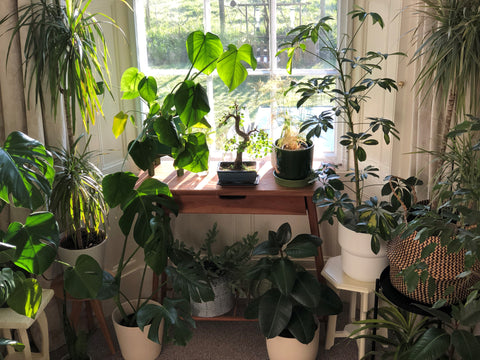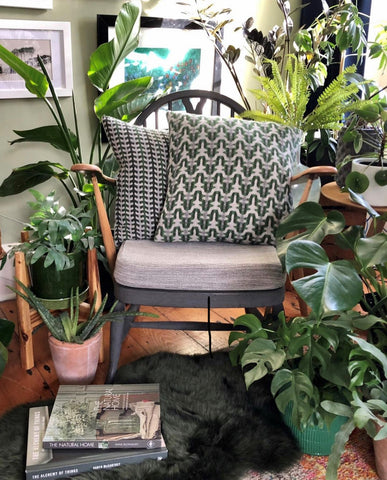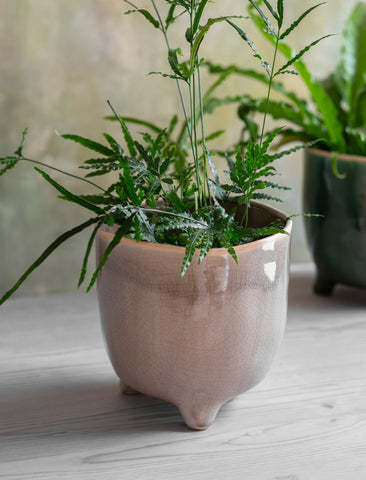Why you need house plants in your home
You have probably heard a lot recently about the many benefits of being out in nature, and how sharing our homes with house plants can help support our wellbeing. Plants are one of natures’ marvels, some remove toxins from the air, some add oxygen into the air and some help you sleep better.
The simple joy of tending to, and watching your plants grow is a wonderful mindful living practice, one that many people took up as a new hobby during lockdown.

Create an indoor garden, like this one sits on a half landing of a staircase
More people are now recognising that plants are great to have around the home, and how these powerful green allies are helping to remove toxins from our indoor air. This is great news when you consider the 2012 report from the Environmental Protection Agency found that indoor pollution can be up to 5 times higher than outdoors.

Best indoor plants for removing toxins
Houseplants are like leafy angels, quietly working hard in the background, helping to keep your indoor air clean. NASA's 1989 Clean Air study published a long list of house plants that are most effective at purifying the air, these include:
Rubber Plant
Boston fern
English Ivy
Snake Plant
Bamboo Palm
Spider Plant
Aloe Vera
Gerbera
Areca palm
This is a great list as these are all super easy to care for plants, perhaps with exception of the Boston fern which can be a little tricky. It's worth remembering though that NASA's study was carried out in controlled test environments not in domestic settings. One or two house plants won't be enough to generate the same results at home, but that's good news if you have a plant buying habit and love an indoor jungle.

Create a plant throne reading nook
But air purification is not the only great reason to bring plants into your home; plants are good for your mental health. Bristol University and University College London conducted studies finding that a friendly bacterium in soil activates brain cells to produce serotonin which can alter behaviour in a similar way to anti-depressants. Serotonin is known as the ‘happy hormone’, a natural antidepressant and mood lifter; it also strengthens the immune system and can help provide a general sense of wellbeing.

Making a space for house plants in your home gives you a direct, visual connection to the natural world – especially important if you don’t have a view onto greenery. Studies have shown that a view onto nature or living greenery is beneficial for our wellbeing, helping to calm and relax us.

Living with house plants is the easiest way to bring real elements of nature inside our homes. In nature we experience greenery at different focal lengths and heights, sometimes all around us so it's a great idea to position your house plants at a variety of heights. Try a combination of hanging planter with trailing varieties, then on several surface heights throughout your home. This reflects how you experience greenery outdoors – remember, it’s not all on one level.

Top Tips for plant care & styling ideas
1. Gather, don’t isolate
Plants are sociable and love being close to their leafy friends, so try not to isolate one plant, it will get lonely. Try grouping your plants in pods of 3 or 5 or make an indoor garden in a light bright corner of your home.
2. Display at a variety of heights
Just as you would experience plants and greenery at different heights outdoors, use a variety of species positioned at varying heights to create a more immersive experience
3. Create a view
If you don’t have a view onto greenery, create one indoors by positioning plants close to windows, use window boxes outside too, which help create the illusion of a green view.
4. Water on a need to basis
Be mindful not to over water, this is how most people kill their plants. Check plants every 4-5 days during spring and summer (more in warmer weather, less in winter). The simplest way to check if plants need water is to stick a finger into the soil. If it comes out dry they need a drink.
5. Shower & Shine
Whilst being super careful not to over water plants, every few months place them in the bath and/or shower and give them a good soaking. Once they’ve been cleaned, make sure to carefully wipe any dust and dirt from leaves. A layer of dust on the foliage will block sunlight and reduce the plant's ability to photosynthesize.
6. Feed during the growing season
Now is the time to be feeding your house plants, without food they won’t bloom to their full potential. Always opt for an organic plant instead of nasty chemicals. Over time the soil becomes depleted, so you need to add plant food to replace the lost nutrients your plants continue to need. Plants which are fed properly become stronger, with more efficient roots.
7. Pot Correctly
When it is time to repot your plants, ensure you have the correct pot size. As a rule, the new pot should only be about 2 inches wide than the old pot. If you repot into a much larger container, the roots are surrounded by too much soil meaning your plant can't draw the water from it fast enough, leaving it wet too long and drowning the roots. A smaller amount of soil will dry out more quickly which allows more oxygen to reach the roots.
8. General Maintenance
Don’t forget to deadhead flowers, remove brown leaves (even healthy plants get the odd brown leaf) and prune when necessary. General plant maintenance will help keep you green babies blooming.
9. Get your hands dirty
Get those hands dirty and don’t wear gloves to repot your houseplants. Let the dirt get under your nails and embrace those friendly soil bacteria. Give the soil a good sniff to, the earthy aroma is also good for you.
10. Location, Location, Location
Do you research on any new plant you bring home. Read up on where it is most likely to be happiest, don’t just plonk it anywhere. Different plants favour better with varying degrees of light, some can tolerate lower levels. Snake Plants for example can tolerate low light but they do still need some light, don’t shove them in the darkest corner and expect them to flourish.
On warm sunny days take plants outside for a few hours to soak up some extra sunlight, especially helpful for any that are in the darker spots in your home or if you have any that are struggling.

Looking for new plants pots? You can find all these plant pots featured in this blog post in store now at our Caldbeck shop
